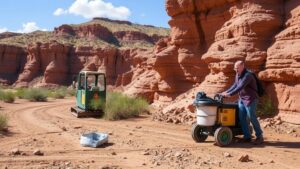Recovering Flour Gold From Black Sands Without Specialized Equipment
Recovering Flour Gold From Black Sands Without Specialized Equipment
Gold recovery from black sands has become an interesting challenge for hobbyists and prospectors alike. This article focuses on how to effectively recover flour gold from black sands using methods that do not require specialized equipment. Through understanding the composition of black sands, and employing practical techniques, you can maximize your chances of successfully extracting precious metals.
Understanding Black Sands
Black sands predominantly consist of heavy minerals such as magnetite and hematite, along with silicate materials. e heavy materials accumulate in riverbeds and beaches due to their higher density compared to lighter materials like gold. The first step in recovery is to understand the characteristics of black sands:
- They often contain fine gold particles, often referred to as flour gold.
- They can absorb moisture, making wet processing methods more effective.
- They can pose challenges in separation due to similar densities and sizes of gold and black sand particles.
Basic Principles of Gold Recovery
Before delving into methods to recover flour gold, its crucial to understand that gold is denser than most black sands. This property can be exploited using gravitational separation techniques, which is the foundation of the recovery process.
Methods to Recover Flour Gold
1. Panning
Panning is one of the oldest and most accessible methods for recovering gold from black sands. The process involves the use of a pan, usually made of metal or plastic:
- Fill your pan with a mixture of black sand and material from the riverbed.
- Add water to the pan and swirl it gently. The lighter materials will wash away, while the denser materials will settle at the bottom.
- Continue to rinse until only a small amount of material remains, which should contain flour gold.
Statistics show that skilled panners can recover approximately 90% of the gold in a pan, especially with practice.
2. Using a Sluice Box
While there are commercially available sluice boxes, you can create a simple one using materials such as plastic or wood. A sluice box works by creating a stream of water that carries material while allowing heavier particles, like gold, to settle:
- Set the sluice at a slight angle to allow water to flow efficiently.
- Add your black sand material into the sluice while maintaining a steady flow of water.
- The riffles in the sluice will trap the heavier gold particles, allowing lighter materials to wash away.
A well-constructed sluice box can increase gold recovery rates significantly, sometimes exceeding 95%.
3. Magnet Method
Magnetism can be employed to aid in the separation process. Black sand often contains magnetite, which can be easily removed from the pan or sluice with the use of a magnet. To use this method:
- Run your black sand material through your pan or sluice first.
- Once youve separated lighter materials, pass a magnet along the surface of the remaining sands.
- The magnet will attract the magnetic particles, allowing you to remove them, leaving behind a concentrate that is richer in flour gold.
Real-World Applications
These methods have been utilized successfully in various regions. For example, prospectors in Californias rivers frequently employ panning and sluicing techniques, emphasizing their effectiveness. Notably, hobbyists report recovering significant amounts of flour gold from beaches in Alaska using improvised equipment.
Conclusion and Actionable Takeaways
Recovering flour gold from black sands can be achieved without specialized equipment by using simple techniques such as panning, sluicing, and magnet separation. Key takeaways include:
- Understand the composition of black sands and the behavior of gold during separation.
- Practice panning and build a sluice box using available materials to enhance recovery rates.
- Employ magnetism to streamline the process and enhance recovery efficiency.
By applying these techniques, you can effectively recover flour gold from black sands, making your prospecting efforts both rewarding and educational.



